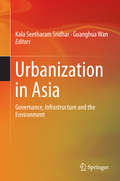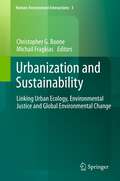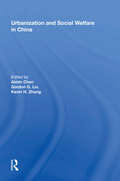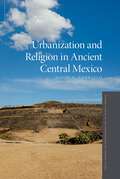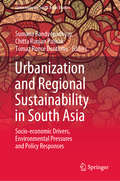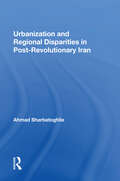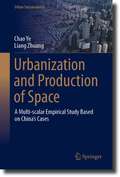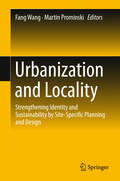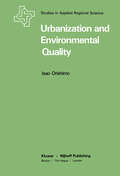- Table View
- List View
Urbanization in China: The Path to Harmony and Prosperity (Research Series on the Chinese Dream and China’s Development Path)
by Houkai WeiThis book traces the history of urbanization in China and discusses major problems and challenges the country is facing as it undergoes a profound social transformation. The author argues that as China tries to build not just more but also better cities, i.e., cities that are not only economically competitive but also people- and environment-friendly, it should adopt urbanization strategies and policies that promote integrated development for both rural and urban areas, and coordination among otherwise disparate objectives – such as industrialization, ecological modernization, informatization and cultural heritage preservation – nationwide and at various scales.
Urbanization in Asia: Governance, Infrastructure and the Environment
by Kala Seetharam Sridhar Guanghua WanThis work focuses on urban governance in the developing world, its aim being to bring a holistic perspective to the debate on urban governance in Asia and around the globe. It has been divided into three sections: The first section is on rural interventions as they influence urbanization and its problems/solutions. The second focuses on urban governance, infrastructure programs, service delivery reforms and their evaluation. The third and final section focuses on urbanization and the environment.In the first section, we present evaluations of India’s rural programs including the Mahatma Gandhi National Rural Employment Guarantee Act (MGNREGA), and of India’s Total Sanitation Campaign. This section covers the transition from rural to urban areas, and highlights coping mechanisms in urban areas and policy implications for urban governance, from the viewpoint of rural migrants.The section on urban governance, infrastructure and service delivery is the most in-depth and consists of papers that present state-of-the-art research on many aspects of infrastructure such as cost and time overruns, risks and their mitigation, assessments of the metro rail, and services such as solid waste management.The focus of the final section is on urbanization and the environment. Here we examine land use change in India, the relationship between urban form and residential energy use in Bandung, Indonesia, and end by depicting a cautiously optimistic view of Asia’s urbanization-environment nexus.
Urbanization in a Federalist Context
by Roscoe MartinThe emergence of America as a metropolitan-urban society has had profound consequences for every phase of national life, but nowhere has its effects been greater than in the domain of government. The growth of the city and its evolution into the metro-city has led to problems more complex and intense than any previously known. These problems command the concern and resources of all governments, federal as well as state and local; for as they have gained general attention they have emerged as national problems.Coincident with national involvement in problems once held to be local has come a rise in federal government relations with the cities. Such relations, though in fact of long standing, have increased greatly in number and intensity since 1933. The result is a significant expansion in the practice of federalism, one marked by the emergence of the cities as partners in the federal system. Urbanization in a Federalist Context treats the expanded federal partnership in urban growth and argues that it is not a fact to be welcomed.Martin traces the expansion of federal authority in the United States from the 1930s through the 1960s. He shows how local issues become national issues, and also how national authority expands, affecting all aspects of location government. The developments he explores reflect a federal system in the process of constant but evolutionary growth. Martin reveals why the relationship between the federal system and metro-cities is a flexible arrangement, capable of adjusting to new demands-but not without its own risks. This classic will be of continuing interest to those concerned about the consequences of the expansion of government authority in the United States.
Urbanization in a Federalist Context
by Roscoe MartinThe emergence of America as a metropolitan-urban society has had profound consequences for every phase of national life, but nowhere has its effects been greater than in the domain of government. The growth of the city and its evolution into the metro-city has led to problems more complex and intense than any previously known. These problems command the concern and resources of all governments, federal as well as state and local; for as they have gained general attention they have emerged as national problems.Coincident with national involvement in problems once held to be local has come a rise in federal government relations with the cities. Such relations, though in fact of long standing, have increased greatly in number and intensity since 1933. The result is a significant expansion in the practice of federalism, one marked by the emergence of the cities as partners in the federal system. Urbanization in a Federalist Context treats the expanded federal partnership in urban growth and argues that it is not a fact to be welcomed.Martin traces the expansion of federal authority in the United States from the 1930s through the 1960s. He shows how local issues become national issues, and also how national authority expands, affecting all aspects of location government. The developments he explores reflect a federal system in the process of constant but evolutionary growth. Martin reveals why the relationship between the federal system and metro-cities is a flexible arrangement, capable of adjusting to new demands-but not without its own risks. This classic will be of continuing interest to those concerned about the consequences of the expansion of government authority in the United States.
Urbanization, Biodiversity and Ecosystem Services: A Global Assessment
by Thomas Elmqvist, Michail Fragkias, Julie Goodness, Burak Güneralp, Peter J. Marcotullio, Robert I. McDonald, Susan Parnell, Maria Schewenius, Marte Sendstad, Karen C. Seto and Cathy WilkinsonUrbanization is a global phenomenon and the book emphasizes that this is not just a social-technological process. It is also a social-ecological process where cities are places for nature, and where cities also are dependent on, and have impacts on, the biosphere at different scales from local to global. The book is a global assessment and delivers four main conclusions:Urban areas are expanding faster than urban populations. Half the increase in urban land across the world over the next 20 years will occur in Asia, with the most extensive change expected to take place in India and China Urban areas modify their local and regional climate through the urban heat island effect and by altering precipitation patterns, which together will have significant impacts on net primary production, ecosystem health, and biodiversityUrban expansion will heavily draw on natural resources, including water, on a global scale, and will often consume prime agricultural land, with knock-on effects on biodiversity and ecosystem services elsewhereFuture urban expansion will often occur in areas where the capacity for formal governance is restricted, which will constrain the protection of biodiversity and management of ecosystem services
Urbanization And Urban Policies In Pacific Asia
by Roland J FuchsThis book is the outcome of the Conference on Population Growth, Urbanization, and Urban Policies in the Asia-Pacific Region, held in Honolulu during 8-12 April 1985. It provides wide attention among development planners, urban managers, and scholars in the field of urban and development planning.
Urbanization And Urban Policies In Pacific Asia
by Roland J FuchsThis book is the outcome of the Conference on Population Growth, Urbanization, and Urban Policies in the Asia-Pacific Region, held in Honolulu during 8-12 April 1985. It provides wide attention among development planners, urban managers, and scholars in the field of urban and development planning.
Urbanization and Urban Governance in China: Issues, Challenges, and Development (Governing China in the 21st Century)
by Lin YeThis book explores the process of urbanization and the profound challenges to China’s urban governance. Economic productivity continues to rise, with increasingly uneven distribution of prosperity and accumulation of wealth. The emergence of individual autonomy including demands for more freedom and participation in the governing process has asked for a change of the traditional top-down control system. The vertical devolution between the central and local states and horizontal competition among local governments produced an uneasy political dynamics in Chinese cities. Many existing publications analyze the urban transformation in China but few focuses on the governance challenges. It is critical to investigate China’s urbanization, paying special attention to its challenges to urban governance. This edited volume fills this gap by organizing ten chapters of distinctive urban development and governance issues.
Urbanization and the Migrant in British Cinema: Spectres of the City
by Gareth MillingtonThis book examines a cycle of films about migration made in the late 1990s and 2000s. It argues that these films present a novel (and radical) aesthetic of planetary urbanization based upon the mobility of the migrant and the dissolution of the city. A stimulating cinematic analysis of our expanding urban fabric, it offers an alternative to the ‘cultural cityism’ of many other films about migration. The author demonstrates that this particular film cycle offers a rare, sustained consideration of the travails and struggles for urban life by migrants beyond and without the city. Yet the city haunts these films like a spectre: the city that has been lost, the ‘present’ city that excludes and the possible ‘cities of refuge’ of the future. Offering new insights into the cinematic portrayal of the figure of the migrant and how this is constructed in relation to urbanization processes, this book will appeal to students and scholars of sociology, film and media studies, human geography, and urban studies.
Urbanization and Sustainability: Linking Urban Ecology, Environmental Justice and Global Environmental Change (Human-Environment Interactions #3)
by Christopher G. Boone and Michail FragkiasCase studies explore the Million Trees initiative in Los Angeles; the relationship of cap-and-trade policy, public health, greenhouse gas emissions and environmental justice in Southern California; Urbanization, vulnerability and environmental justice in the Brazilian cities of Rio de Janeiro, Curitiba and São Paulo, and in Antofagasta, Greater Concepción and Valparaiso in Chile; Sociospatial patterns of vulnerability in the American southwest; and Urban flood control and land use planning in Greater Taipei, Taiwan ROC.
Urbanization and Socio-Economic Development in Africa: Challenges and Opportunities (Routledge African Studies #16)
by Steve Kayizzi-Mugerwa Abebe Shimeles Nadège Désirée YaméogoThe main goal of this book is to put urbanization and its challenges squarely on Africa’s development agenda. Planned urbanization can improve living conditions for the majority, help in the expansion of the middle class, and create conditions for economic transformation. However, many African cities have developed haphazardly, resulting in the decline of public services, in slum proliferation, and increases in poverty. African cities thrive on activities characterized by easy entry and low productivity, generally referred to as the "informal sector". Indeed, today some urban dwellers are poorer than their cousins in the countryside. In spite of reform attempts, many governments have not been able to create an enabling environment, with adequate infrastructure and institutions to sustain markets for easy exchange and production. This study argues that with careful policies and planning, the situation can be changed. If the recent natural resource-led economic boom that we have seen in many African countries is used for structural reforms and urban renewal, African cities could become centers of economic opportunity. The challenge for African policymakers is to ensure that urban development is orderly and that the process is inclusive and emphasizes the protection of the environment, hence green growth.
Urbanization and Socio-Economic Development in Africa: Challenges and Opportunities (Routledge African Studies)
by Steve Kayizzi-Mugerwa Abebe Shimeles Nadège Désirée YaméogoThe main goal of this book is to put urbanization and its challenges squarely on Africa’s development agenda. Planned urbanization can improve living conditions for the majority, help in the expansion of the middle class, and create conditions for economic transformation. However, many African cities have developed haphazardly, resulting in the decline of public services, in slum proliferation, and increases in poverty. African cities thrive on activities characterized by easy entry and low productivity, generally referred to as the "informal sector". Indeed, today some urban dwellers are poorer than their cousins in the countryside. In spite of reform attempts, many governments have not been able to create an enabling environment, with adequate infrastructure and institutions to sustain markets for easy exchange and production. This study argues that with careful policies and planning, the situation can be changed. If the recent natural resource-led economic boom that we have seen in many African countries is used for structural reforms and urban renewal, African cities could become centers of economic opportunity. The challenge for African policymakers is to ensure that urban development is orderly and that the process is inclusive and emphasizes the protection of the environment, hence green growth.
Urbanization and Social Welfare in China
by Gordon G. LiuChina's urban population growth rate has doubled in the past 20 years and the Chinese government has made further urbanization a developmental priority. How Chinese cities cope with such rapid population increases has become a question of critical concern. This book provides an analysis of the welfare implications of China's urbanization, the development of the labour market including migration between rural and urban sectors, and natural and social environmental issues arising from urbanization. The book covers both academic and policy perspectives and, together with its sister volume Urban Transformation in China, brings together a comprehensive and multi-disciplinary overview of China's urbanization.
Urbanization and Social Welfare in China
by Gordon G. LiuChina's urban population growth rate has doubled in the past 20 years and the Chinese government has made further urbanization a developmental priority. How Chinese cities cope with such rapid population increases has become a question of critical concern. This book provides an analysis of the welfare implications of China's urbanization, the development of the labour market including migration between rural and urban sectors, and natural and social environmental issues arising from urbanization. The book covers both academic and policy perspectives and, together with its sister volume Urban Transformation in China, brings together a comprehensive and multi-disciplinary overview of China's urbanization.
Urbanization and Religion in Ancient Central Mexico (Oxford Studies in the Archaeology of Ancient States)
by David M. CarballoUrbanization and Religion in Ancient Central Mexico examines the ways in which urbanization and religion intersected in pre-Columbian central Mexico, with a primary focus on the later Formative period and the transition to the Classic period. The major societal transformations of this interval occurred approximately two-thousand years ago and over a millennium before Mexico's best known early civilization, the Aztecs. David M. Carballo presents a synthesis of data from regional archaeological projects and key sites such as Teotihuacan and Cuicuilco, while relying on his own excavations at the site of La Laguna as the central case study. A principal argument is that cities and states developed hand in hand with elements of a religious tradition of remarkable endurance and that these processes were fundamentally entangled. Prevalent religious beliefs and ritual practices created a cultural logic for urbanism, and as populations urbanized they became socially integrated and differentiated following this logic. Nevertheless, religion was used differently over time and by groups and individuals across the spectra of urbanity and social status. The book provides a materially informed history of religion, with the temporal depth that archaeology can provide, and an archaeology of cities that considers religion seriously as a generative force in societal change.
Urbanization and Religion in Ancient Central Mexico (Oxford Studies in the Archaeology of Ancient States)
by David M. CarballoUrbanization and Religion in Ancient Central Mexico examines the ways in which urbanization and religion intersected in pre-Columbian central Mexico, with a primary focus on the later Formative period and the transition to the Classic period. The major societal transformations of this interval occurred approximately two-thousand years ago and over a millennium before Mexico's best known early civilization, the Aztecs. David M. Carballo presents a synthesis of data from regional archaeological projects and key sites such as Teotihuacan and Cuicuilco, while relying on his own excavations at the site of La Laguna as the central case study. A principal argument is that cities and states developed hand in hand with elements of a religious tradition of remarkable endurance and that these processes were fundamentally entangled. Prevalent religious beliefs and ritual practices created a cultural logic for urbanism, and as populations urbanized they became socially integrated and differentiated following this logic. Nevertheless, religion was used differently over time and by groups and individuals across the spectra of urbanity and social status. The book provides a materially informed history of religion, with the temporal depth that archaeology can provide, and an archaeology of cities that considers religion seriously as a generative force in societal change.
Urbanization and Regional Sustainability in South Asia: Socio-economic Drivers, Environmental Pressures and Policy Responses (Contemporary South Asian Studies)
by Sumana Bandyopadhyay Chitta Ranjan Pathak Tomaz Ponce DentinhoThis book examines urbanization and migration processes in South Asia. By analyzing the socio-economic impacts and infrastructural, environmental and institutional aspects of different conurbations, it highlights conflicts over agricultural land as well as the effects on health, education, poverty and the welfare of children, women and old people. The authors also explore issues of mobility; connectivity and accessibility of public services, and discuss the effective use of new urban-management tools, such as the concept of smart cities and urban spatial monitoring.
Urbanization And Regional Disparities In Post-revolutionary Iran
by Ahmad SharbatoghlieIran's rapid population growth, coupled with a legacy of political and administrative centralization, has led to acute regional disparities. Although the roots of these inequalities can be traced back to the monarchical era, this book shows how the Revolution and subsequent developments have significantly affected the social and economic conditions of urban and rural areas in post-revolutionary Iran. Considering geographic, demographic, structural and policy factors, the author presents a multi-levelled analysis of Iran's current situation and offers a proposal for a more balanced future development strategy.
Urbanization And Regional Disparities In Post-revolutionary Iran
by Ahmad SharbatoghlieIran's rapid population growth, coupled with a legacy of political and administrative centralization, has led to acute regional disparities. Although the roots of these inequalities can be traced back to the monarchical era, this book shows how the Revolution and subsequent developments have significantly affected the social and economic conditions of urban and rural areas in post-revolutionary Iran. Considering geographic, demographic, structural and policy factors, the author presents a multi-levelled analysis of Iran's current situation and offers a proposal for a more balanced future development strategy.
Urbanization and Production of Space: A Multi-scalar Empirical Study Based on China's Cases (Urban Sustainability)
by Chao Ye Liang ZhuangThis book studies China’s urbanization with the theory of production of space. The authors redefine the production of space and build a new theoretical framework for understanding the evolving relations between urbanization and spatial production. Since the reform and opening-up, especially in the last twenty years, the logic of spatial production has dominated China’s urbanization. The authors choose the most representative cases, such as the Yangtze River Delta Urban Agglomeration, Jiangsu Province, National High-tech Industrial Development Zone, New Urban District, State-Level New Area, University Town, and some villages, to conduct a series of empirical studies on production of space at the macro-, meso-, and micro-scales. Through an in-depth analysis of the interaction between social spaces and urbanization influenced by power, capital, and class, the book reveals that the essence of China’s urbanization is dominated by the logic of spatial production. The authors finally propose that an important shift toward humanism should be made in the future development of China’s new-type urbanization, emphasizing more even and adequate development between different regions and between urban and rural areas, which also provides new ideas for the theory and practice of urbanization worldwide.This book can be read and referenced by researchers in the fields of urban and regional studies, geography, sociology, urban and rural planning, management, etc. It can also be used as a teaching reference book for teachers, researchers, and students of scientific research institutions in related fields.
Urbanization and Locality: Strengthening Identity and Sustainability by Site-Specific Planning and Design
by Fang Wang Martin ProminskiBased on a discussion of conflicts in the urbanization process, this book provides theoretical and practical solutions for the preservation and development of urban localities. On the basis of informative case studies, it reveals the similarities and unique aspects of urbanization in Germany and China. The process of urban growth and the future trend of locality and urbanization are also examined. The book gathers contributions from architects, landscape designers, environmental engineers, urban planners and geographers, who analyze urban issues from their individual perspectives and provide methods for preserving and developing urban localities. As such, it expresses responses to urban development trends against the backdrop of sustainability in the 21st century.
Urbanization and Its Impact in Contemporary China (Research Series on the Chinese Dream and China’s Development Path)
by Peilin LiThis book addresses a wide range of social issues in connection with urbanization, which is providing new momentum for China’s economic restructuring and social progress, including the educational gap; the middle class in urbanization; consumption; division of labor; and social integration. All chapters are based on updated nation-wide sampling survey data. Taken together, they provide a lens for understanding various aspects of urbanization and its impacts on China’s economy and society.
Urbanization and Environmental Quality (Studies in Applied Regional Science #21)
by I. OrishimoThe purpose of this monograph is to clarify the effect of environmental change on the process of urbanization. The research attempts to uncover the similarities as well as the differences across countries of the charac teristics of environmental effects on cities and metropolitan areas during the process of industrial development. Over the past several decades, a notable behavioral shift has been observed in many developed countries. People appear to be switching from an almost exclusive concern for material (commodity) consumption to a broader set of concerns that includes interest in so-called environ mental problems and in improving the quality of life (USEPA 1973). These new areas of concern include, of course, the problems of pollution, congestion, and, in general, environmental degradation in urban areas. People seem to be becoming increasingly conscious of the physical as well as the social environment. Richard L. Morrill described the situation in the United States as follows: Evidently many are still moving [their residences] for amenity values, into regions they like, irrespective of job opportunities. While movement to the traditional amenity areas of Florida and Arizona continues, there has been a dramatic shift away from California, or from metropolitan areas generally, to xv xvi INTRODUCTION the Pacific Northwest, the Rocky Mountains, upper New England, and even to the Ozarks, Appalachia, and Upper Michigan. [Quoted in Berry and Gillard 1977, p.
Urbanization And Development: The Rural-urban Transition In Taiwan
by Paul K LiuThe growth and expansion of cities and the transition from a rural to an urban society are among the most critical links between population change and economic development. On the one hand, migration is one of the fundamental demographic processes associated with changes in the population of urban places; the changing distribution of population be
Urbanization And Development: The Rural-urban Transition In Taiwan
by Paul K LiuThe growth and expansion of cities and the transition from a rural to an urban society are among the most critical links between population change and economic development. On the one hand, migration is one of the fundamental demographic processes associated with changes in the population of urban places; the changing distribution of population be

